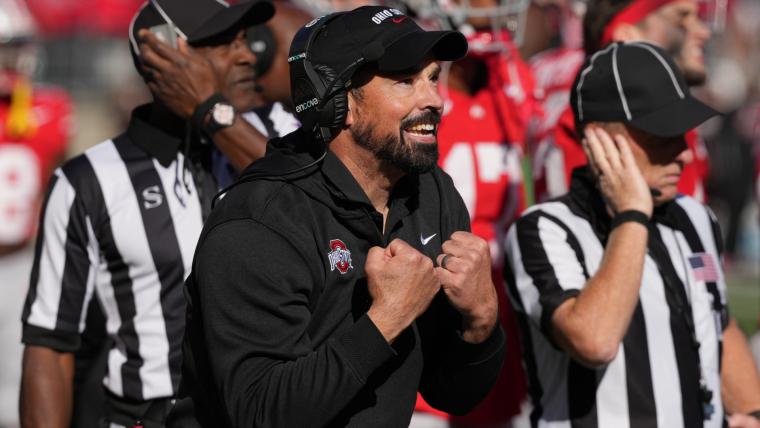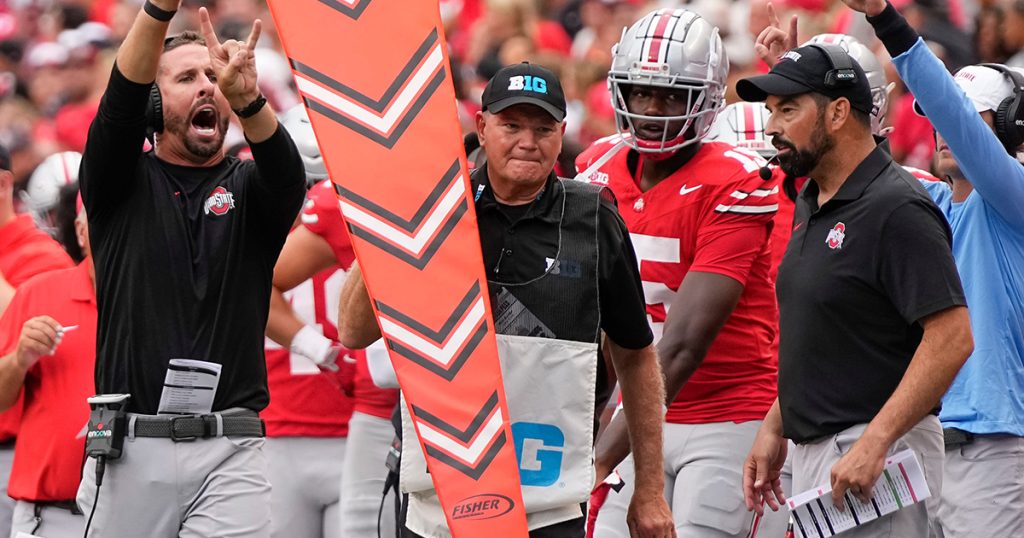No. 1 Oregon and No. 2 Ohio State have locked in their positions at the top of the AP Poll for the second consecutive week. As we look ahead to the second set of College Football Playoff (CFP) rankings set to be released on Tuesday, it appears these rankings will remain unchanged. But here’s where the intrigue lies: when we translate these rankings into the 12-team playoff bracket, the Ducks emerge as the No. 1 seed, while the Buckeyes drop to No. 5. This discrepancy raises a critical question: why don’t the College Football Playoff rankings align with the bracket?
Understanding the Rankings vs. Bracket Dilemma
The latest AP Top 25 gives us a glimpse into what the upcoming CFP rankings might look like. However, when we map these rankings onto a 12-team playoff bracket, the inconsistencies become glaringly obvious.
| RANK | RANKINGS | BRACKET |
| 1 | Oregon | Oregon |
| 2 | Ohio State | Texas |
| 3 | Penn State | BYU |
| 4 | Texas | Miami |
| 5 | Indiana | Ohio State |
| 6 | Tennessee | Penn State |
| 7 | BYU | Tennessee |
| 8 | Notre Dame | BYU |
| 9 | Alabama | Notre Dame |
| 10 | Ole Miss | Alabama |
| 11 | Georgia | Ole Miss |
| 12 | Miami | Boise State |
It’s perplexing. The current playoff structure seems to inflate the importance of conference championship games within the Power 5 conferences. This leads to a perception that it’s more beneficial to have a lower seed for an at-large bid from the Big Ten or SEC. The regular season’s value is diminished for teams like Ohio State and Oregon, and the solution is simple: we need to apply some common sense.
Why Do the CFP Rankings Differ from the Bracket Seeding?
To understand the disconnect, let’s consider the Ducks and Buckeyes. They faced off in a thrilling game on October 12, which Oregon won 32-31 at Autzen Stadium. Fast forward to the potential Big Ten championship game between these two teams. The winner would secure a top-four seed, while the loser might plummet to the No. 5 or No. 6 seed, even if they were ranked No. 3 or No. 4 in the final CFP rankings. How does that make sense?
The top four highest-ranked conference champions—likely from the ACC, Big Ten, Big 12, and SEC—will receive those coveted first-round byes. Meanwhile, the highest-ranked Group of 5 champion could also snag a bye. This system seems increasingly outdated, especially with three conferences boasting 16 or more teams. When you strip away the revenue and the trophy that most fans couldn’t identify, the flaws become glaringly apparent.
The Impact on Regular Season Value
Would Oregon truly be rewarded for maintaining the No. 1 ranking throughout the regular season if they were to drop to the fifth or sixth seed after a loss in a rematch against Ohio State? Ohio State’s schedule could include four top-five matchups, including two against Oregon and a potential showdown with No. 5 Indiana on November 23. If Indiana finishes 11-1 or 12-1, shouldn’t they also be in the conversation for a first-round bye?
While the regular season remains entertaining, the stakes feel lower when the outcomes don’t come with meaningful rewards. This isn’t a blanket condemnation of conference championship games; they can still serve as a way to determine automatic qualifiers. However, the Big Ten and SEC, which are both heavily represented in the rankings, illustrate why these games shouldn’t automatically guarantee first-round byes.
The Case for Seeding and Matchups
The debate continues over whether it’s better to be the No. 5 or No. 6 seed in this playoff format. This notion is frustrating, as it suggests that a lower seed might actually have an easier path to the semifinals. For instance, if Ohio State were the No. 5 seed, they would face No. 12 Boise State in the first round, a matchup that seems more favorable compared to No. 1 Oregon, which would take on the winner of the 8-9 game.
If we go strictly by the rankings, Ohio State should be the No. 2 seed, facing the winner of No. 7 BYU and No. 10 Ole Miss. How does that not make more sense? The seeding system is convoluted, and it’s clear that fixing it is essential for the integrity of the playoff.
How to Fix the Problem
So, how can we address these issues? A straightforward solution would be to use the rankings to seed teams 1-12 after the conference championship games. While I would personally eliminate the conference championship games, keeping them could still work if we adjust the seeding process.
In most seasons, the four Power 4 conference champions will likely be ranked within the top 12. The Group of 5 champion may not make the cut, but that’s acceptable. For example, Georgia, currently ranked No. 11, might not qualify for the playoffs, but they still have a solid chance of competing.
Does this format favor the Big Ten and SEC? Absolutely. But given that these conferences have consistently produced top-tier teams, it’s only fair they receive a larger share of the playoff spots.
The NFL playoffs face similar challenges, with division winners getting home games while only one team receives a bye. The best team in the conference should be rewarded for their regular-season performance.
Ultimately, we need to ensure that the rankings align with the bracket. The integrity of college football depends on it, and fans deserve a system that truly reflects the best teams in the nation.





























